
Peckoltia is a genus of small South American armored suckermouth catfishes. Many of these fish are popular aquarium fish.

Loricariinae is a subfamily of the family Loricariidae of catfish. This subfamily is divided into two tribes and about 30 genera. They are mainly native to freshwater habitats in South America, but there are also several species in Panama and a single (Fonchiiichthys) in Costa Rica.
Harttiella is a genus of armored catfishes native to South America.
Reganella depressa is the only species of the monotypic genus Reganella, a genus of the family Loricariidae of catfish. R.depressa is a poorly known species and uncommon in collections. Its phylogenetic position remains uncertain.
Rhadinoloricaria is a genus of catfish endemic to South America. It was considered to be monotypic until the 2020 discovery of a second species.
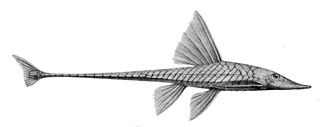
Sturisoma is a genus of armored catfishes native to Central and South America.
Harttia is a genus of armored catfishes native to South America.
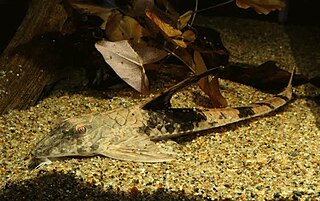
Loricaria is a genus of armored catfish native to South America.

The Hypostominae are a subfamily of catfishes of the family Loricariidae. Most members are restricted to tropical and subtropical South America, but there are also several species in southern Central America. Hypostomus plecostomus, which is popular in the aquarium trade, has been introduced to several regions far from its native range.

Ancistrini is a tribe of catfishes of the family Loricariidae. Most are restricted to tropical and subtropical South America, but there are also several genus in southern Central America.

Sturisomatichthys is a genus of armored catfishes native to Central and South America.
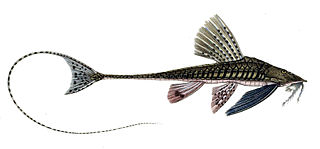
Paraloricaria is a genus of armored catfishes native to South America.
Dasyloricaria is a genus of armored catfishes native to Central and South America. The distribution of these species includes the northwestern South America on the Pacific slope of Colombia and Panama. Its distribution is restricted to the Pacific slope of the Andes, which is a unique pattern of distribution within the subfamily.
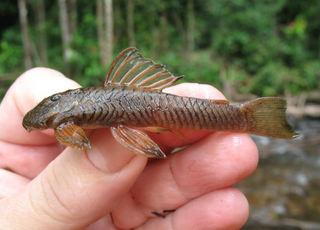
Guyanancistrus is a genus of suckermouth armored catfishes.

Panaqolus is a genus of small catfish in the family Loricariidae native to rivers in tropical South America. Its members were formerly thought to belong to a clade of small-sized species in the genus Panaque, until this genus was separated from Panaque in 2001. At times it has been considered a subgenus of Panaque, and the validity of the genus has been disputed by various authors and sources. Pseudoqolus koko was formerly considered to be a member of this genus, although it was reclassified as a member of the currently monotypic genus Pseudoqolus by Nathan K. Lujan, Christian A. Cramer, Raphael Covain, Sonia Fisch-Muller, and Hernán López-Fernández following a 2017 molecular phylogenetic analysis.

Guyanancistrus nassauensis is a species of catfish belonging to the family Loricariidae, the suckermouth armored catfishes. It is discovered in 2005 and formally described in 2018. G. nassauensis is a rare species, highly endemic to the Nassau Mountains in Suriname, and is threatened with extinction by proposed or ongoing mining activities.
Pseudoqolus koko is a species of catfish in the family Loricariidae and the only species in the genus Pseudoqolus. It is a freshwater fish native to South America, where it occurs in the Maroni basin. It is usually found on or near stony substrates in the main river channel at a depth of around 2 m. The species has been collected alongside multiple other loricariid species, including Hemiancistrus medians, Peckoltia otali, Pseudancistrus barbatus, Harttia guianensis, Loricaria cataphracta, and Rineloricaria stewarti. It is noted that the gut contents of one specimen of this species contained primarily spicules and sponge fragments, indicating that it may feed on freshwater sponges. The species reaches 9 cm SL.
'Pseudancistrus' megacephalus is a species of catfish in the family Loricariidae. It is of uncertain and disputed classification.

Cryptancistrus similis is a species of catfish in the family Loricariidae and the only member of the monotypic genus Cryptancistrus. It is a freshwater fish native to South America, where it occurs in the upper Paru de Oeste River in Brazil. The species reaches 6.2 cm in standard length. It was described in 2018 by Sonia Fisch-Muller, Jan Mol, and Raphael Covain as part of a taxonomic review of the genus Guyanancistrus, which Cryptancistrus was found to be distinct from but closely related to. Its specific epithet, similis, is derived from Latin and references the species' similarity to the species of Guyanancistrus, specifically Guyanancistrus brevispinis.
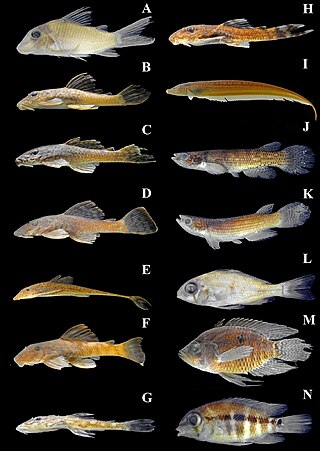
Cteniloricaria napova is a species of catfish in the family Loricariidae. It is native to South America, where it occurs in the upper Paru de Oeste River basin in Suriname. The species reaches 12.9 cm (5.1 in) in standard length and is believed to be a facultative air-breather. Its specific name, napova, is derived from the Tiriyó language and means "thank you", honoring the Tiriyó people of Sipaliwini District for collecting and providing specimens of the species.











